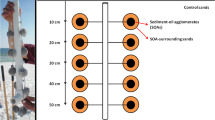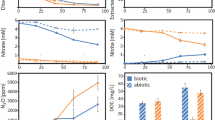Abstract
CONTAMINATION of ground waters with water-soluble aromatic hydrocarbons, common components of petroleum pollution, often produces anoxic conditions under which microbial degradation of the aromatics is slow1–7. Oxygen is often added to contaminated ground water to stimulate biodegradation, but this can be technically difficult and expensive1,5–8. Insoluble Fe(III) oxides, which are generally abundant in shallow aquifers, are alternative potential oxidants, but are difficult for microorganisms to access9. Here we report that adding organic ligands that bind to Fe(III) dramatically increases its bioavailability, and that in the presence of these ligands, rates of degradation of aromatic hydrocarbons in anoxic aquifer sediments are comparable to those in oxic sediments. We find that even benzene, which is notoriously refractory in the absence of oxygen, can be rapidly degraded. Our results suggest that increasing the bioavailability of Fe(III) by adding suitable ligands provides a potential alternative to oxygen addition for the bioremediation of petroleum-contaminated aquifers.
This is a preview of subscription content, access via your institution
Access options
Subscribe to this journal
Receive 51 print issues and online access
$199.00 per year
only $3.90 per issue
Buy this article
- Purchase on Springer Link
- Instant access to full article PDF
Prices may be subject to local taxes which are calculated during checkout
Similar content being viewed by others
References
Salanitro, J. P. Ground Wat. Monitor. Remed. 13, 150–161 (1993).
Acton, D. W. & Barker, J. F. J. Contamin. Hydrol. 9, 325–352 (1992).
Barker, J. K., Major, P. & Major, D. Ground Wat. Monitor. Rev. 7, 64–71 (1987).
Gillham, R. W., Starr, R. C. & Miller, D. J. Ground Wat. 28, 858–862 (1990).
Thomas, J. M. & Ward, C. H. Envir. Sci. Technol. 23, 760–766 (1989).
Major, D. W., Mayfield, C. I. & Barker, J. F. Ground Wat. 26, 8–14 (1988).
Lee, M. D. et al. CRC Crit. Rev. Envir. Control 18, 29–89 (1988).
Morgan, P. & Watkinson, R. J. Wat. Res. 26, 73–78 (1992).
Lovley, D. R. Microbiol. Rev. 55, 259–287 (1991).
Wilson, B. H., Smith, G. B. & Rees, J. F. Envir. Sci. Technol. 20, 997–1002 (1986).
Kuhn, E. P., Zeyer, J., Eicher, P. & Schwarzenbach, R. P. Appl. Envir. Microbiol. 54, 490–496 (1988).
Beller, H. R., Grbic-Galic, D. & Reinhard, M. Appl. Envir. Microbiol. 58, 786–793 (1992).
Edwards, E. A. & Grbic-Galic, D. Appl. Envir. Microbiol. 58, 2663–2666 (1992).
Grbic Galic, D. & Vogel, T. Appl. Envir. Microbiol. 53, 254–260 (1987).
Pardieck, D. L., Bouwer, E. J. & Stone, A. T. J. Contamin. Hydrol. 9, 221–242 (1992).
Anid, P. J., Alvarez, P. J. J. & Vogel, T. M. Wat. Res. 27, 685–691 (1993).
Flyvbjerg, J., Arivn, E., Jensen, B. K. & Olsen, S. K. J. Contamin. Hydrol. 12, 133–150 (1993).
Barbaro, J. R., Barker, J. F., Lemon, L. A. & Mayfield, C. I. J. Contamin. Hydrol. 11, 245–272 (1992).
Hutchins, S. R., Sewell, G. W., Kovacs, D. A. & Smith, G. A. Envir. Sci. Technol. 25, 68–76 (1991).
Hutchins, S. R. Envir. Toxicol. Chem. 10, 1437–1448 (1991).
Lovley, D. R. et al. Nature 339, 297–299 (1989).
Lyngkilde, J. & Christensen, T. H. J. Contamin. Hydrol. 10, 291–307 (1992).
Baedecker, M. J., Cozzarelli, I. M., Siegel, D. I., Bennett, P. C. & Eganhouse, R. P. Appl. Geochem. 8, 569–586 (1993).
Arnold, R. G., DiChristina, T. J. & Hoffmann, M. R. Biotechnol. Bioengng. 32, 1081–1096 (1988).
Vroblesky, D. A. & Chapelle, F. H. Wat. Resour. Res. 30, 1561–1570 (1994).
Lovley, D. R., Chapelle, F. H. & Woodward, J. C. Envir. Sci. Technol. (in the press).
Lovley, D. R. & Phillips, E. J. P. Appl. Envir. Microbiol. 53, 2636–2641 (1987).
Roden, E. E. & Lovley, D. R. Appl. Envir. Microbiol. 59, 734–742 (1993).
Author information
Authors and Affiliations
Rights and permissions
About this article
Cite this article
Lovley, D., Woodward, J. & Chapelle, F. Stimulated anoxic biodegradation of aromatic hydrocarbons using Fe(III) ligands. Nature 370, 128–131 (1994). https://doi.org/10.1038/370128a0
Received:
Accepted:
Issue Date:
DOI: https://doi.org/10.1038/370128a0
This article is cited by
-
Coupled iron cycling and organic matter transformation across redox interfaces
Nature Reviews Earth & Environment (2023)
-
Electromicrobiology: the ecophysiology of phylogenetically diverse electroactive microorganisms
Nature Reviews Microbiology (2022)
-
Anaerobic benzene mineralization by natural microbial communities from Niger Delta
Biodegradation (2021)
-
Identification of naphthalene carboxylase subunits of the sulfate-reducing culture N47
Biodegradation (2019)
-
Advances in Fe(III) bioreduction and its application prospect for groundwater remediation: A review
Frontiers of Environmental Science & Engineering (2019)
Comments
By submitting a comment you agree to abide by our Terms and Community Guidelines. If you find something abusive or that does not comply with our terms or guidelines please flag it as inappropriate.



